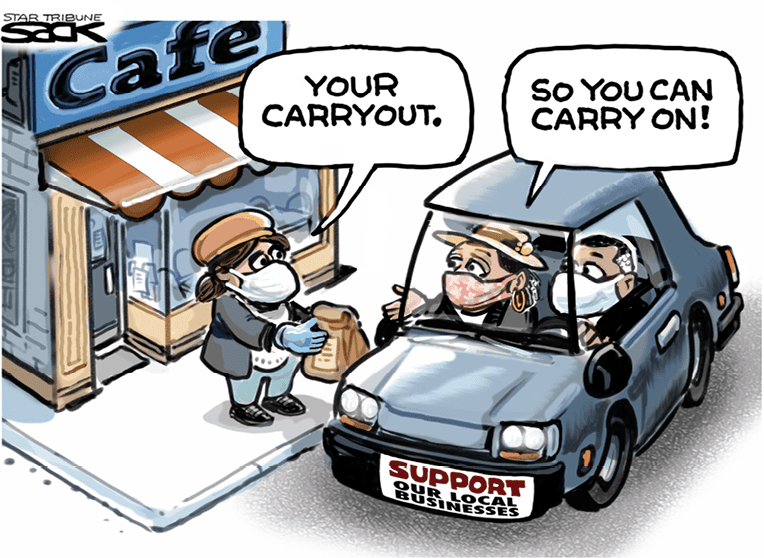Proper use of masks is key to their efficacy
COVID is not a hoax. It's not like the flu. It has dangers unique to it that medical experts are still discovering. As the world sees the second wave of COVID, Niagara seems to be a bit of an island in terms of infection numbers. New cases per day seem to be around 20 or so for a population of about 450,000.
Yet there is much consternation over people not following the rules. Masks were pitched in the summer as the way to keep infections down. One has to wonder if the surge in cases, even where masks are mandatory indoors, is all due to people not following the rules? Masks can reduce the spread, but governments seem to think they are some panacea when the infection numbers seem to say otherwise. Perhaps it's just an easy bylaw that cities and towns have no interest in enforcing? Look, look we're doing something! Enforcement is purely the responsibility of business owners. Any walk through a store will see masks worn improperly and stored in cars improperly. According to the Public Health Ontario website: "Wearing a mask can help to prevent the spread of some respiratory illnesses, but it can also become a source of infection if not worn or discarded properly. If you need to wear a mask, you should also be sure to clean your hands frequently with soap and water or alcohol-based hand sanitizer."
We spent months getting used to social distancing in public places, which, by the way, is still the gold standard in infection prevention.
So far, governments and public health units have issued advice that caters to the most cautious among us. Life is an exercise in risk management. Each time you start your car and enter a road, risk is there. Going for a walk in your neighbourhood is a risk. Staying at home, where falls can happen, is a risk.
As a vaccine is hopefully on the horizon, I feel Niagara residents have done a pretty good job at controlling COVID. Of course, our low population density, low reliance on public transit and low population per dwelling unit help immeasurably versus larger cities.
Peter Leyser Fonthill
Editor’s note: Proper mask usage is indeed key to their effectiveness, particularly now that we know COVID remains present in the air for much longer than initially thought, and in micro-particle, aerosolized form. In fact, the “gold standard” of COVID safety is never leaving the house, just as the gold standard of auto safety is never riding in a car, and the gold standard of flight safety is never getting on an airplane. That’s not how life works, as the writer points out. Therefore we look to “silver standards” instead: Seatbelts and airbags in cars; a century of engineering advances in aircraft; and wearing face masks to reduce the spread of the deadly, airborne, respiratory virus called COVID-19.

Thanks from the Fenwick Lions
The Fabulous Fenwick Lions Club would like to thank the residents of Fenwick and surrounding area for making our 2020 Fish Fry an outstanding success.
All those attending adhered to all COVID-19 protocols which greatly helped and was appreciated.
We would also like to thank the Town of Pelham and the Niagara Public Health in providing the protocols we were required to follow to keep everyone safe.
Last but not least were the Fabulous Fenwick Lions Club members and other volunteers that came out at each Fish Fry even with the COVID-19 threat.
Lion Jeff Pickup 1st VP & Secretary

"Criminal" paving over of Niagara continues apace
May your mayor, Marvin Junkin, and all the councillors take time to digest the important forewarning thoughts in the excellent letter of E. J. Smith [“Open letter to Mayor Junkin,” Letters, Nov. 18, p.6].
What are all of you leaving for future generations? They certainly won't be left the pleasure of hunting tadpoles as described by Mr. Smith.
It is criminal how quickly everywhere one looks across Niagara there is nothing but building and paving over, with no thought to the connection humans have with nature, especially the developing minds of children.
City people are coming to Niagara for a better, quieter, life, while in return cities are springing up in that quieter once greener space. Do the city people realize they are coming to a place with few doctors, hospital services and real local jobs?
Faye Suthons Wainfleet
COMMENTARY / OP-ED | Dr. Mustafa Hirji
Why the newly imposed indoor dining rules make sense
An office worker spends her lunch break with a co-worker. A parent gets together with a sibling’s family on the weekend so that the children can play with their cousins. Someone meets up with a friend for dinner.
These three innocent social interactions all led to COVID-19 infections in Niagara over the last few days.
COVID-19 spreads when people are physically close. The longer we are close together, the greater the risk. As a result, close social interaction is the greatest risk activity for catching COVID-19.
It is also why long-term care and retirement homes see so much infection—these are people’s homes, where interacting with each other is common. Indeed, after long-term care and retirement homes, family homes are the second most common setting for COVID-19 to spread.
To stop the spread of COVID-19, we need to break up in-person social interactions. Keeping 2 metres distance, erecting clear acrylic barriers, and wearing masks are all ways that we can interrupt normal social interaction, thereby making it safer. Most effective, of course, is not to have the social interaction in the first place. Indeed, this is why lockdowns work—people stay home and don’t interact socially with one other, preventing infection from spreading.
Often people are vigilant about taking precautions such as keeping distance and wearing masks while around others in public, but they are more relaxed around their friends, co-workers, and extended family with whom they feel safe. We aren’t likely to interact closely—or if we do, for very long—with strangers in public, but we do interact with those important people around whom we feel comfortable. And so the risk of COVID-19 is tragically highest around those we know and trust. Indeed, in the past week, Public Health traced new COVID-19 infections back to an identifiable person as the source in almost 76% of cases—identifiable because these were the known social contacts with whom the newly infected persons had interacted.
This is the great challenge of COVID-19. Social interaction, a fundamental part of human existence, is what puts us at risk. And the lack of this socializing makes us long evermore for that social connection the more we are without it.
Over the past three months, COVID-19 has been rising in Canada. In Ontario just this past week, the Ontario government put more parts of the province into the Red-Control level, and moved both Toronto and Peel Region into lockdowns. These moves severely restrict economic activity in hopes of breaking-up social interactions.
In Niagara, we have remained in the Orange-Restrict level, but are at risk of joining our neighbours of Hamilton and Halton Region in the Red-Control level if our trajectory of cases rising continues.
Unfortunately, the only way to change this course is to curtail our social interactions voluntarily, before they are severely restricted by the provincial government. And just as staying home during the lockdown helped us control COVID-19 in the spring, voluntarily limiting our social interactions to just our households could deliver us the rapid reduction in COVID-19 cases that we seek.
I recently released a letter urging us as a community to do just this: limit our social interactions to only our households for a period (making exceptions for persons outside of our household who are important to our physical and mental wellbeing).
This is what public health authorities have been recommending for over six weeks now. In recent days, the Ontario government has given this recommendation much more emphasis, and the British Columbia government issued a population-wide order to enforce it in some situations. Locally, there has been much attention to our local order which seeks to limit dining in bars, restaurants, wineries and other food services to just our household (and exceptions as above).
Doing this is not easy.
After 10 months of disruption in our lives, we are understandably struggling with the prospect of losing those important social connections in our lives. There’s no way to make it easier. But it is what we need to do to save lives, 18 of which we have lost in just the last six weeks.
What will hopefully help us is to focus on the prospect that a vaccine to COVID-19 looks much closer than we’d hoped. While it will still be several more months before we can start to get vaccinated, we can now see that finish line is coming up. And like any marathon runner, we can pace ourselves with a few milestones to get there.
First up are the upcoming winter holidays. These are normally a time of social gatherings with our families. While we likely won’t be in a position for our normal winter festivities this year, if over the next four weeks we can drive our cases lower, we will be able to buy ourselves room to have a little more social interaction over the holidays.
Let us all commit as a community to this goal, and find ways to keep to just our households for the next four weeks so that we can enjoy the holidays a little before pushing to the next milestone. ◆
COMMENTARY / OP-ED | Larry Coté
Our seniors deserve better care
One of the elements encountered in life is change. It is inevitable, whether one chooses to embrace it or resist it. One of the social changes that has taken place over the past few decades is elder care. Recently, this subject has become quite controversial and made headlines in conjunction with the COVID pandemic.
Historically, senior care was a family matter. Very often senior folks lived as part of the family unit. Grandparents living their later years among the grandchildren was the norm. Often the task of providing this care fell on the shoulders of female descendants of the seniors.
However, that normalcy began to change as more options for senior care emerged. Some entrepreneurial types set up households and took in seniors to live out their lives in facilities that, in many ways, resembled their own. These facilities became casually known as “old folks homes.” Some religious orders set up facilities to care for seniors as part of their charitable commitment.
Subsequent years saw the development of municipally built near-hospital like settings, euphemistically referred to as retirement homes or seniors’ centres. But municipalities could not keep up with the demand and opportunistic entrepreneurs entered the marketplace for seniors’ care. The municipally operated facilities were not-for-profit enterprises but the privately owned facilities were primarily designed to earn a profit.
Some of these privately operated senior housing facilities are richly decorated and available only to prospective seniors who can afford the fees. Such accommodation fees are substantially higher than the publicly operated facilities, which offer more humble surroundings.
Due to the contagious nature of the COVID virus, many seniors’ facilities experienced—and continued to experience— higher infection rates than the community at large. Worse, because some residents have compromised immune systems, the mortality rate of those infected is often much higher than in the general population.
These matters about senior care have highlighted the need for serious deliberations. High among these is whether such facilities should be integrated into the current healthcare system. During this pandemic, some seniors facilities were overwhelmed by the in-house spread of the disease. Consequently, the government temporarily transferred the governance of these operations to the community healthcare system.
In other instances, where senior care providers were overwhelmed by the pandemic, the military was brought in to provide support. Subsequently, they gave a scathing report on the inadequacies and poor conditions present in some of these facilities. Since much of the care provided is decidedly health- related, there is growing advocacy that these senior care complexes should be integrated with the local health care system.
Additionally, there are some who raised the issue of privately owned senior’s operations, many of which are owned by large chain corporations. The prospects of balancing levels of care and the contribution to the bottom line might, at times, be conflicting priorities.
If there be any positive outcomes following this pandemic, then a better system of caring for our seniors could just be among such positives. That surely would be welcomed change. ◆
PELHAM AND COVID-19 | Mayor Marvin Junkin
As Niagara Region inches closer to a Red-control designation, Toronto and Peel regions have been put into lockdown. These lockdowns, among other restrictions, will shutter salons and gyms, and force restaurants to provide take-out only, as indoor and outdoor dining at restaurants is banned. Retail businesses and department stores not selling essential items will only be allowed to open for curbside pickup and delivery, with customers not allowed inside. Schools and daycares will remain open. The lockdown began this Monday, and is scheduled to last 28 days. To help businesses affected by the lockdown, the Ford government has set aside $600 million to help with fixed costs, such as property taxes and hydro bills.
Back in Niagara, we have seen 117 new infections since last Thursday, with 36 on Saturday alone. Last week the Acting Medical Officer of Health, Dr. Hirji, issued orders that restaurants will be required to confirm patrons dining at tables were of the same household. All councillors of Regional government were inundated with emails from restaurant owners doing business within the region, claiming that they were being singled out by these orders, and these restrictions would force them ever closer to bankruptcy. Regional Council held an emergency meeting last Wednesday to debate the issue and to hear firsthand from restaurant owners and their representatives. The result of that meeting was a motion put on the agenda for our regular council meeting the next day, Thursday, November 19. This motion recommended, among other directives, that Dr. Hirji rescind the order restricting only household members dine together in restaurants. The motion was passed unanimously by council, but at the time of this writing, Dr. Hirji has taken no action. The health boards of Ontario are separate entities unto themselves, not under the jurisdiction of Regional Council. Therefore, we as a council can recommend, but not instruct, the actions of Dr. Hirji.
On the national level it has been decided that the Canada-U.S. border will remain closed, except for essential travellers, until at least December 21. Worst-case scenarios issued by the public health agency of Canada show that Canada could see 60,000 new cases of COVID-19 a day if contact rates continue to increase. British Columbia announced new rules, including mandatory masks for indoor, public, and retail spaces, along with restrictions on social gatherings.
In our town, Pelham Cares has now completed three weeks of their five-week food drive, and they are happy to report that the generosity of Pelham residents remains as high as ever, even in these trying times. No surprise there! At Town Hall itself, council was happy to learn that the CAO, along with the CAOs of Fort Erie and Wainfleet, have been successful in hiring a Town solicitor. Her name is Jennifer Stirton, and although she will be a direct employee of the Town of Pelham, all three municipalities will contribute towards her employment costs. This is yet another example of your council reaching out to our neighbours and exploring avenues where mutual savings can be achieved. ◆



